2D Gallium Sulfide-Based 1D Photonic Crystal Biosensor for Glucose Concentration Detection
Abstract
1. Introduction
2. Biosensor Designs and Theoretical Formulation
3. Numerical Results and Discussion
3.1. Optical Characteristics of the 1D PCs with and without a Defect
3.2. Biosensing Performance of 1D PCs
3.3. Biosensing Performance in the Near-Infrared Range
4. Conclusions
Author Contributions
Funding
Institutional Review Board Statement
Informed Consent Statement
Data Availability Statement
Conflicts of Interest
References
- Ng, A.C.; Delgado, V.; Borlaug, B.A.; Bax, J.J. Diabesity: The combined burden of obesity and diabetes on heart disease and the role of imaging. Nat. Rev. Cardiol. 2021, 18, 291–304. [Google Scholar] [CrossRef] [PubMed]
- Arneth, B.; Arneth, R.; Shams, M. Metabolomics of type 1 and type 2 diabetes. Int. J. Mol. Sci. 2019, 20, 2467. [Google Scholar] [CrossRef] [PubMed]
- Sharma, P.; Hajam, Y.A.; Kumar, R.; Rai, S. Complementary and alternative medicine for the treatment of diabetes and associated complications: A review on therapeutic role of polyphenols. Phytomed. Plus 2022, 2, 100188. [Google Scholar] [CrossRef]
- Daher, M.G.; Jaroszewicz, Z.; Zyoud, S.H.; Panda, A.; Hasane Ahammad, S.K.; Abd-Elnaby, M.; Eid, M.M.; Rashed, A.N.Z. Design of a novel detector based on photonic crystal nanostructure for ultra-high-performance detection of cells with diabetes. Opt. Quantum Electron. 2022, 54, 701. [Google Scholar] [CrossRef]
- Jalil, A.T.; Ashfaq, S.; Bokov, D.O.; Alanazi, A.M.; Hachem, K.; Suksatan, W.; Sillanpää, M. High-sensitivity biosensor based on glass resonance PhC cavities for detection of blood component and glucose concentration in human urine. Coatings 2021, 11, 1555. [Google Scholar] [CrossRef]
- Vijayalakshmi, D.; Manimegalai, C.T.; Ayyanar, N.; Vigneswaran, D.; Kalimuthu, K. Detection of blood glucose with hemoglobin content using compact photonic crystal fiber. IEEE Trans. Nanobiosci. 2021, 20, 436–443. [Google Scholar] [CrossRef]
- Daher, M.G. Supersensitive biosensor based on a photonic crystal nanostructure for blood Sugar level monitoring with ultra-high quality factor and low detection limit. Optik 2023, 275, 170581. [Google Scholar] [CrossRef]
- Habli, O.; Bouazzi, Y.; Kanzari, M. Gas sensing using one-dimensional photonic crystal nanoresonators. Prog. Electromagn. Res. C 2019, 92, 251–263. [Google Scholar] [CrossRef]
- Wei, H.; Chen, X.; Zhao, D.; Zhao, M.; Wang, Y.; Zhang, P. Temperature Sensing Based on Defect Mode of One-Dimensional Superconductor-Semiconductor Photonic Crystals. Crystals 2023, 13, 302. [Google Scholar] [CrossRef]
- Sinibaldi, A. Cancer biomarker detection with photonic crystals-based biosensors: An overview. J. Light. Technol. 2021, 39, 3871–3881. [Google Scholar] [CrossRef]
- Taya, S.A.; Sharma, A.; Doghmosh, N.; Colak, I. Detection of water concentration in ethanol solution using a ternary photonic crystal-based sensor. Mater. Chem. Phys. 2022, 279, 125772. [Google Scholar] [CrossRef]
- Zegadi, R.; Ziet, L.; Satour, F.Z.; Zegadi, A. Design of a wide ranging highly sensitive pressure sensor based on two-dimensional photonic crystals. Plasmonics 2019, 14, 907–913. [Google Scholar] [CrossRef]
- Wang, Z.; Wang, Y.; Yan, J.; Liu, B.; Chen, Y.; Tian, Y.H. Metal-Organic Frameworks-Based Photonic Crystals Platforms for Gas Sensing: A Review. Mater. Adv. 2022, 3, 6728–6741. [Google Scholar] [CrossRef]
- Aly, A.H.; Mohamed, B.A.; Awasthi, S.K.; Abdallah, S.A.O.; Amin, A.F. MATLAB simulation based study on poliovirus sensing through one-dimensional photonic crystal with defect. Sci. Rep. 2023, 13, 9422. [Google Scholar] [CrossRef]
- Parimala Devi, M.; Awasthi, S.K.; Alipour-Banaei, H.; Nambi, R. Refractive index EV sensor based on conventional and mirror image 1D defective photonic crystal designs: Theoretical study. J. Comput. Electron. 2022, 21, 1404–1415. [Google Scholar] [CrossRef]
- Sharma, S.; Kumar, A. Design of a biosensor for the detection of dengue virus using 1D photonic crystals. Plasmonics 2022, 17, 675–680. [Google Scholar] [CrossRef]
- Panda, A.; Pukhrambam, P.D. Investigation of defect based 1D photonic crystal structure for real-time detection of waterborne bacteria. Phys. B Condens. Matter 2021, 607, 412854. [Google Scholar] [CrossRef]
- El Mouncharih, A.; Takassa, R.; Farkad, O.; Tchenka, A.; Elfatouaki, F.; Ibnouelghazi, E.A.; Abouelaoualim, D. One-dimensional photonic crystal-based biosensor for the detection of glucose concentration in human urine. J. Nanophotonics 2023, 17, 026007. [Google Scholar] [CrossRef]
- Abderrahmane, A.; Woo, C.; Ko, P.J. Tunable optoelectronic properties of a two-dimensional graphene/α-In2Se3/graphene-based ferroelectric semiconductor field-effect transistor. J. Mater. Sci. Mater. Electron. 2021, 32, 20252–20258. [Google Scholar] [CrossRef]
- Abderrahmane, A.; Jung, P.G.; Woo, C.; Ko, P.J. Dual-Gate Graphene/h-BN/GaSe Metal–Insulator–Semiconductor Field-Effect Transistor (MISFET). Phys. Status Solidi A 2022, 219, 2100818. [Google Scholar] [CrossRef]
- Abderrahmane, A.; Woo, C.; Ko, P.J. Optoelectronic Properties of Hexagonal Boron Nitride Shielded Molybdenum Diselenide/Black-Phosphorus Based Heterojunction Field Effect Transistor. Coatings 2022, 12, 445. [Google Scholar] [CrossRef]
- Maruvada, A.; Shubhakar, K.; Raghavan, N.; Pey, K.L.; O’Shea, S.J. Dielectric breakdown of 2D muscovite mica. Sci. Rep. 2022, 12, 14076. [Google Scholar] [CrossRef] [PubMed]
- Gutiérrez, Y.; Giangregorio, M.M.; Dicorato, S.; Palumbo, F.; Losurdo, M. Exploring the thickness-dependence of the properties of layered gallium sulfide. Front. Chem. 2021, 9, 781467. [Google Scholar] [CrossRef] [PubMed]
- Jung, C.S.; Shojaei, F.; Park, K.; Oh, J.Y.; Im, H.S.; Jang, D.M.; Park, J.; Kang, H.S. Red-to-ultraviolet emission tuning of two-dimensional gallium sulfide/selenide. ACS Nano 2015, 9, 9585–9593. [Google Scholar] [CrossRef]
- Kato, K.; Umemura, N. Sellmeier equations for GaS and GaSe and their applications to the nonlinear optics in GaSxSe1−x. Opt. Lett. 2011, 36, 746–747. [Google Scholar] [CrossRef]
- Kalita, J.M.; Wary, G. Estimation of band gap of muscovite mineral using thermoluminescence (TL) analysis. Phys. B Condens. Matter 2016, 485, 53–59. [Google Scholar] [CrossRef]
- Ghafari, H.; Hanley, Q.S. Analysis of layered assays and volume microarrays in stratified media. Analyst 2012, 137, 5520–5526. [Google Scholar] [CrossRef]
- Barlow, S.G.; Manning, D.A.C. Influence of time and temperature on reactions and transformations of muscovite mica. Br. Ceram. Trans. 1999, 98, 122–126. [Google Scholar] [CrossRef]
- Castellanos-Gomez, A.; Wojtaszek, M.; Tombros, N.; Agraït, N.; van Wees, B.J.; Rubio-Bollinger, G. Atomically thin mica flakes and their application as ultrathin insulating substrates for graphene. Small 2011, 7, 2491–2497. [Google Scholar] [CrossRef]
- Yeh, Y.L. Real-time measurement of glucose concentration and average refractive index using a laser interferometer. Opt. Lasers Eng. 2008, 46, 666–670. [Google Scholar] [CrossRef]
- Pedrotti, F.L.; Pedrotti, L.M.; Pedrotti, L.S. Introduction to Optics, 3rd ed.; Cambridge University Press: Cambridge, UK, 2008; p. 479. [Google Scholar]
- Armstrong, E.; O’Dwyer, C. Artificial opal photonic crystals and inverse opal structures–fundamentals and applications from optics to energy storage. J. Mater. Chem. C 2015, 3, 6109–6143. [Google Scholar] [CrossRef]
- American Diabetes Association Professional Practice Committee and American Diabetes Association Professional Practice Committee: 2022. 2. Classification and diagnosis of diabetes: Standards of Medical Care in Diabetes—2022. Diabetes Care 2022, 45 (Suppl. S1), S17–S38. [Google Scholar] [CrossRef] [PubMed]
- Zeng, C.; Luo, C.; Hao, L.; Xie, Y. The research on magnetic tunable characteristics of photonic crystal defect localized modes with a defect layer of nanoparticle. Chin. Opt. Lett. 2014, 12, 11602. [Google Scholar] [CrossRef]
- Chen, X.; Gao, Z.; Li, Z.; Wang, J.; Wang, H.; Chen, S.; Shen, J.; Li, C. A High-Sensitivity Sensor Based on Insulator-Metal-Insulator Structure. Photonics 2023, 10, 502. [Google Scholar] [CrossRef]
- Verma, R.K.; Gupta, B.D. Surface plasmon resonance based fiber optic sensor for the IR region using a conducting metal oxide film. J. Opt. Soc. Am. A 2010, 27, 846–851. [Google Scholar] [CrossRef]
- Zaky, Z.A.; Aly, A.H. Highly sensitive salinity and temperature sensor using Tamm resonance. Plasmonics 2021, 16, 2315–2325. [Google Scholar] [CrossRef]


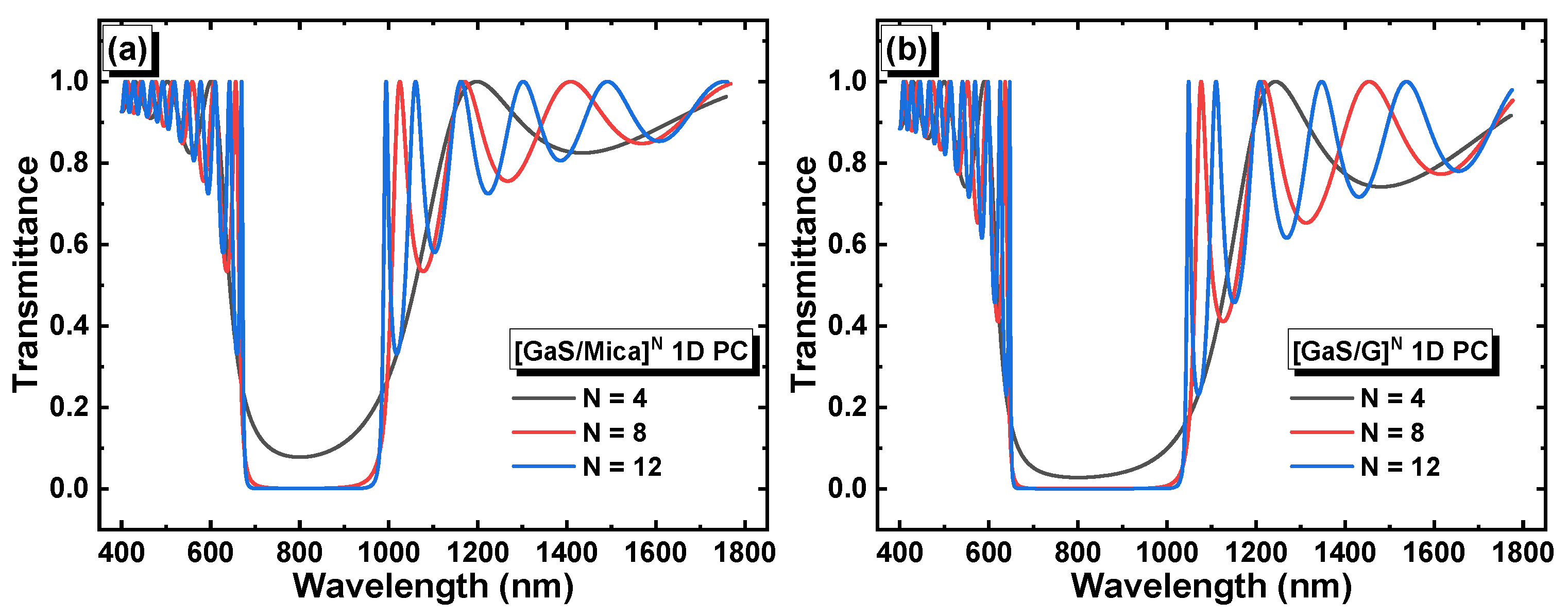
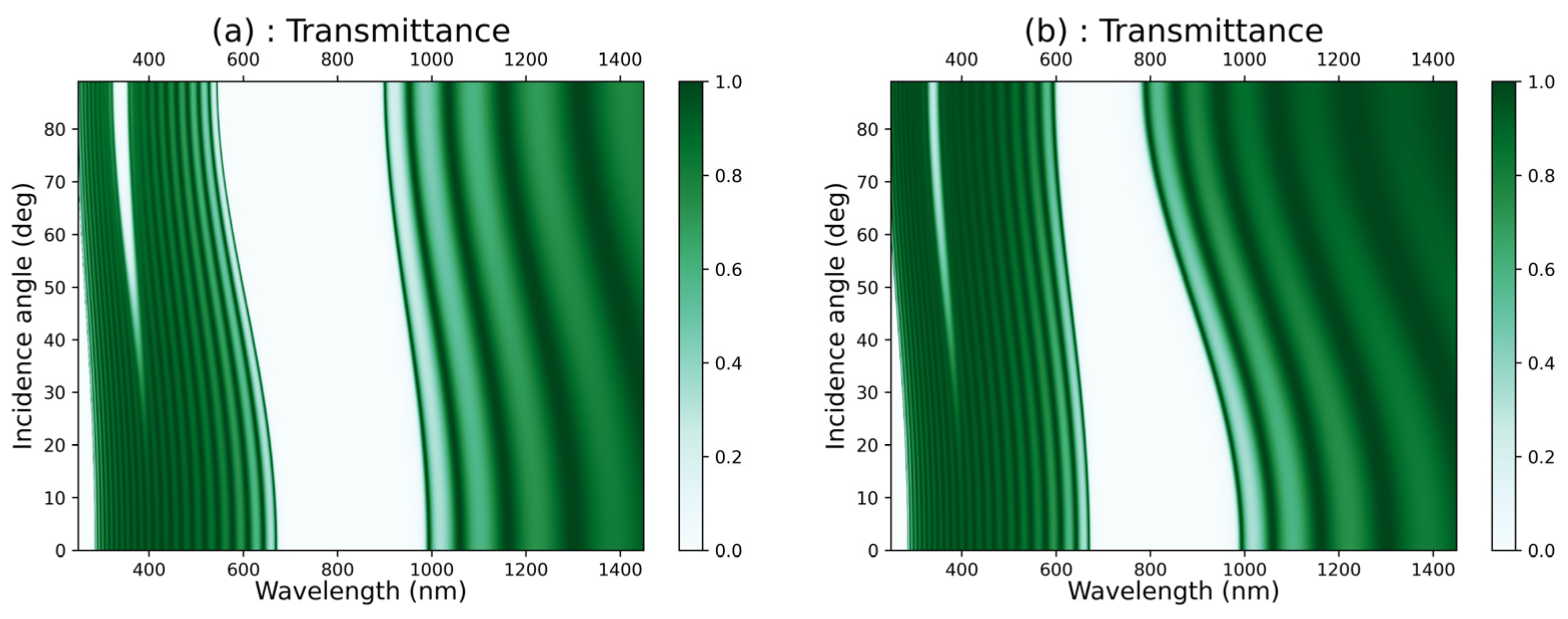
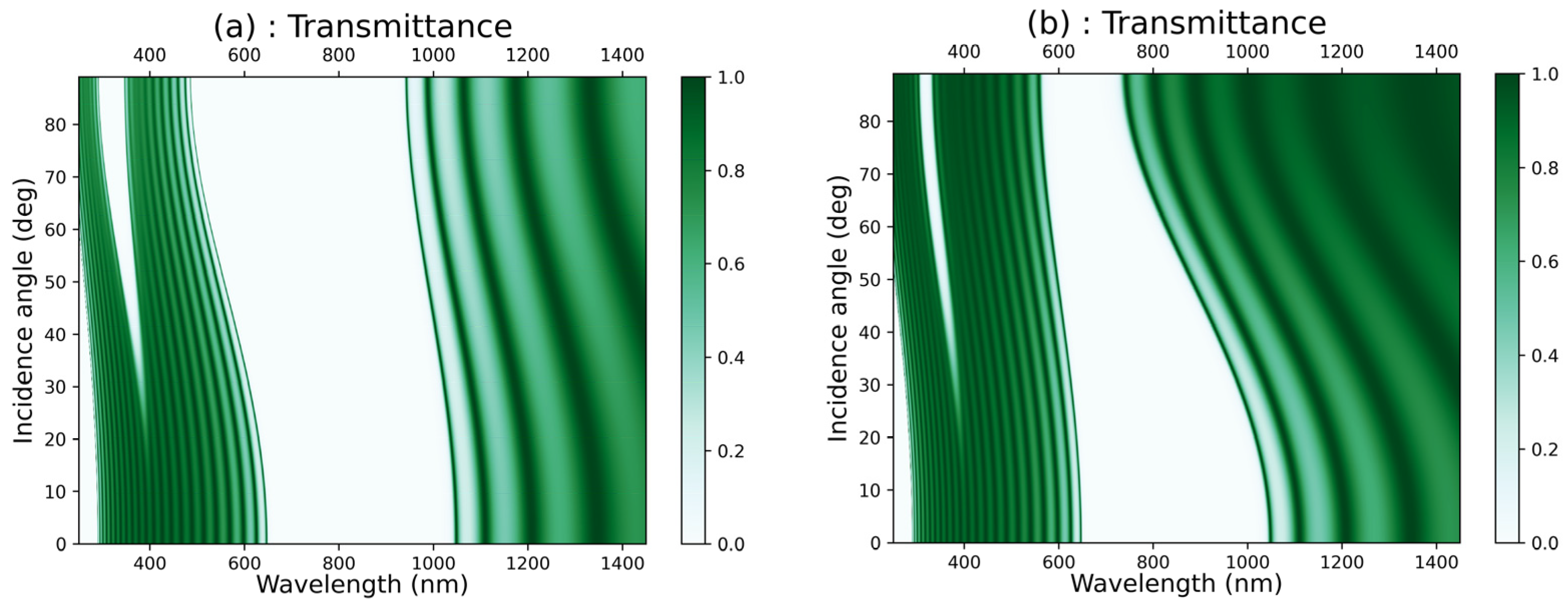

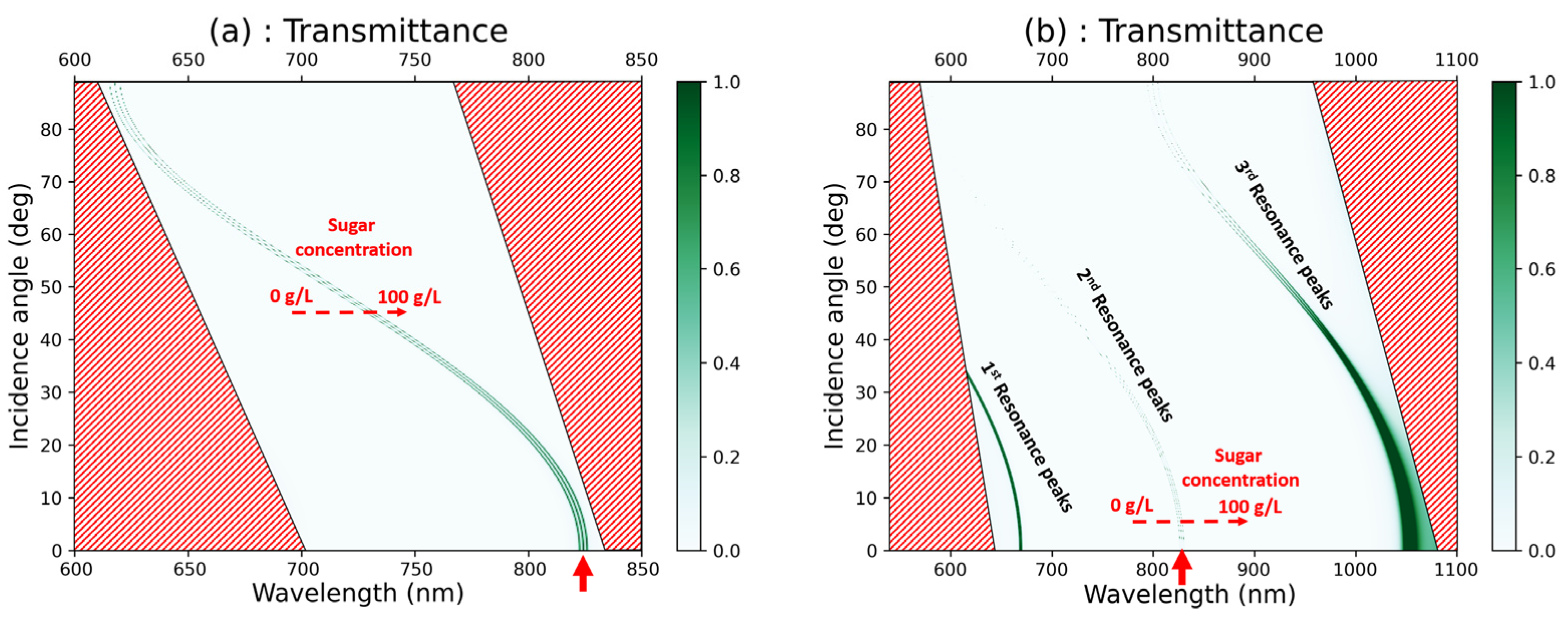
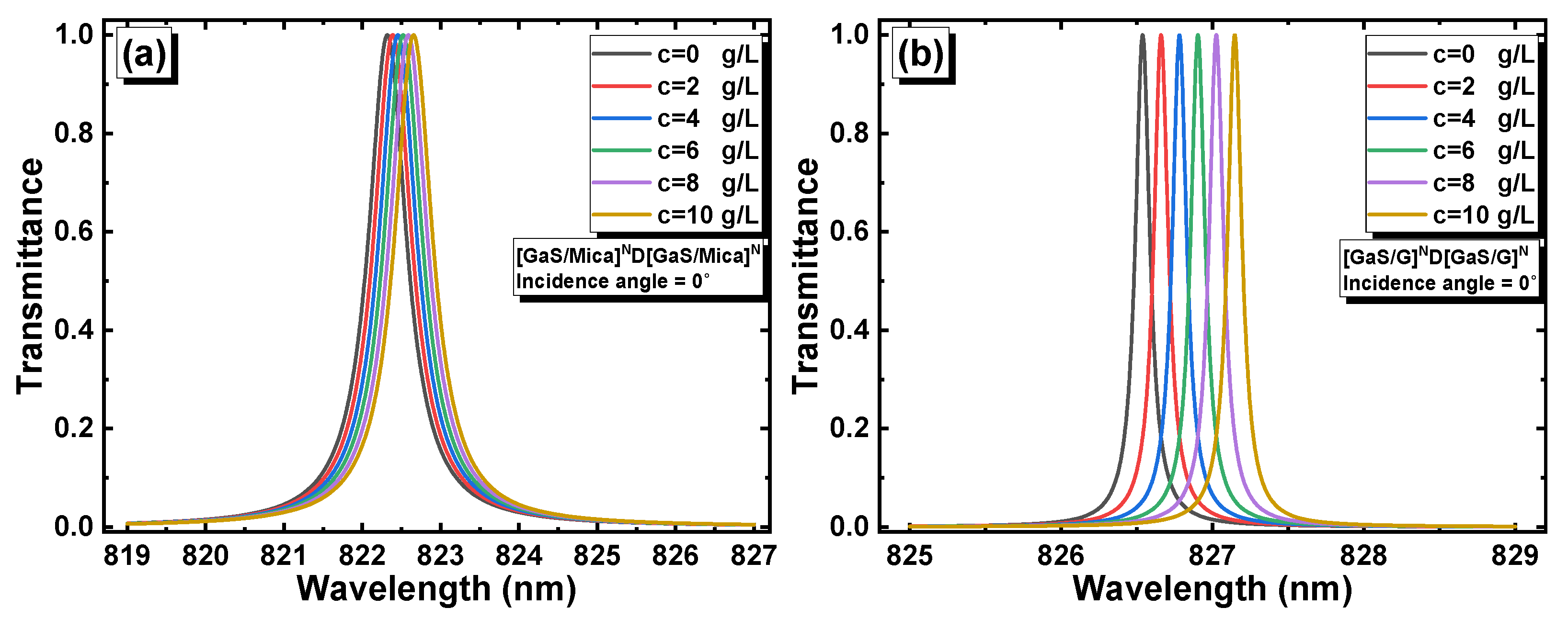
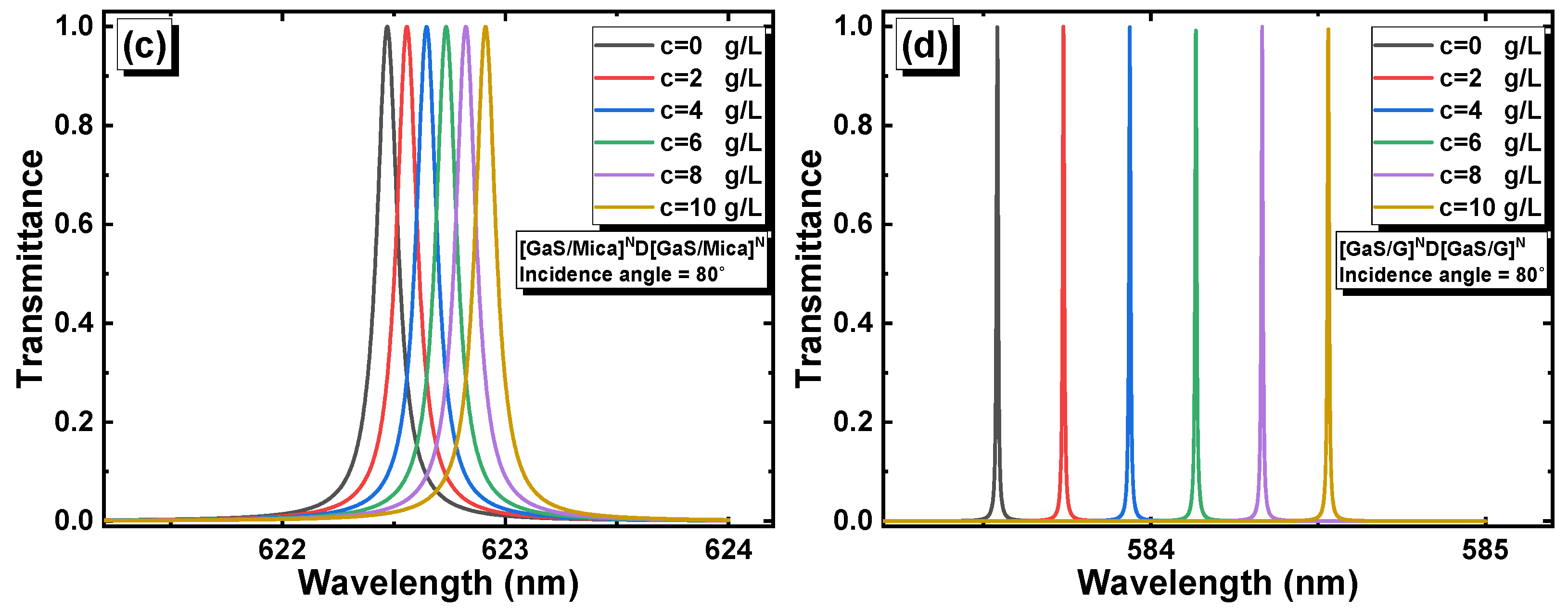
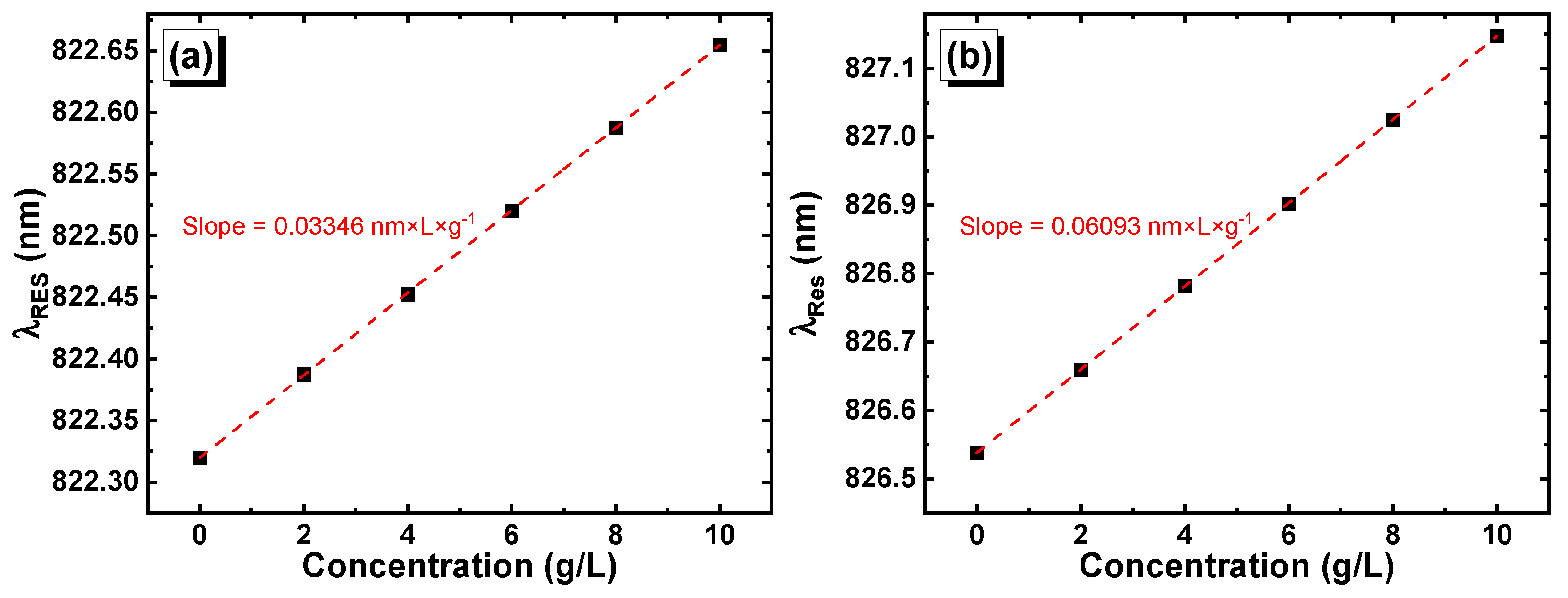
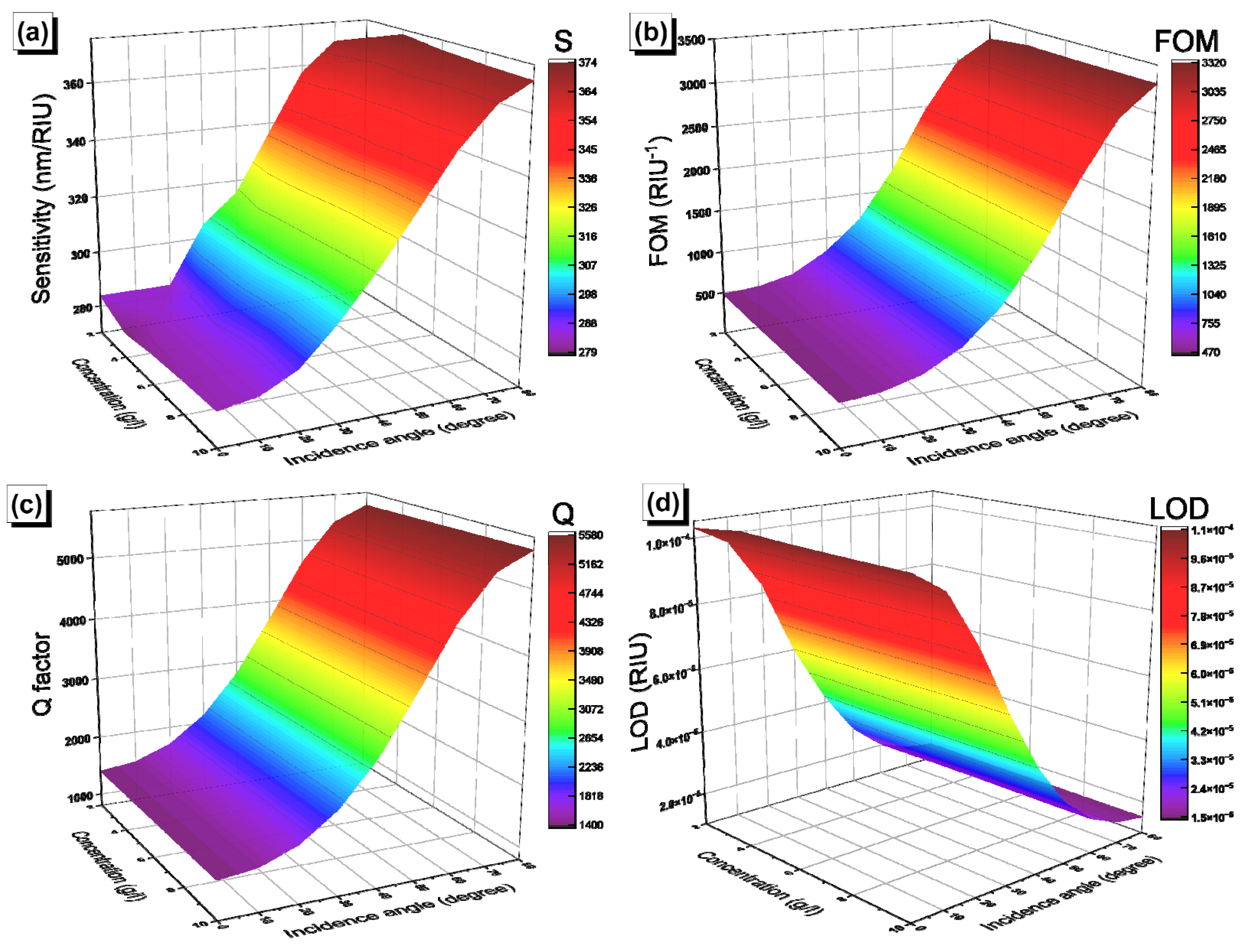



| Concentration | ||||
|---|---|---|---|---|
| 2 g/L | 4040 | 1.80 | 1.01 | 2.77 |
| 4 g/L | 4039 | 1.77 | 0.99 | 2.82 |
| 6 g/L | 4036 | 1.74 | 0.97 | 2.88 |
| 8 g/L | 4034 | 1.70 | 0.95 | 2.93 |
| 10 g/L | 4032 | 1.67 | 0.94 | 2.99 |
Disclaimer/Publisher’s Note: The statements, opinions and data contained in all publications are solely those of the individual author(s) and contributor(s) and not of MDPI and/or the editor(s). MDPI and/or the editor(s) disclaim responsibility for any injury to people or property resulting from any ideas, methods, instructions or products referred to in the content. |
© 2023 by the authors. Licensee MDPI, Basel, Switzerland. This article is an open access article distributed under the terms and conditions of the Creative Commons Attribution (CC BY) license (https://creativecommons.org/licenses/by/4.0/).
Share and Cite
Abderrahmane, A.; Senouci, K.; Hachemi, B.; Ko, P.J. 2D Gallium Sulfide-Based 1D Photonic Crystal Biosensor for Glucose Concentration Detection. Materials 2023, 16, 4621. https://doi.org/10.3390/ma16134621
Abderrahmane A, Senouci K, Hachemi B, Ko PJ. 2D Gallium Sulfide-Based 1D Photonic Crystal Biosensor for Glucose Concentration Detection. Materials. 2023; 16(13):4621. https://doi.org/10.3390/ma16134621
Chicago/Turabian StyleAbderrahmane, Abdelkader, Khaled Senouci, Belkacem Hachemi, and Pil Ju Ko. 2023. "2D Gallium Sulfide-Based 1D Photonic Crystal Biosensor for Glucose Concentration Detection" Materials 16, no. 13: 4621. https://doi.org/10.3390/ma16134621
APA StyleAbderrahmane, A., Senouci, K., Hachemi, B., & Ko, P. J. (2023). 2D Gallium Sulfide-Based 1D Photonic Crystal Biosensor for Glucose Concentration Detection. Materials, 16(13), 4621. https://doi.org/10.3390/ma16134621






